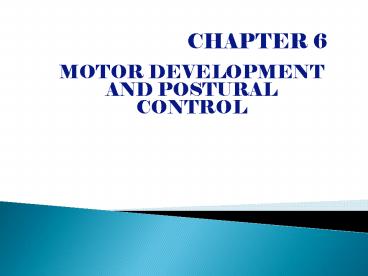Motor Behavior PowerPoint PPT Presentation
1 / 17
Title: Motor Behavior
1
CHAPTER 6 MOTOR DEVELOPMENT AND POSTURAL CONTROL
2
CASE STUDY
INSERT THE CASE STUDY FROM PAGE 69
3
I. RANDOM/REFLEX MOVEMENT
- Newborn will move head, arms and legs
producing some apparently disorganized
movement. - Although movements appear spontaneous and
unorganized, they are actually coordinated and
represent infants first attempts to produce
purposeful movement. - Earliest movements are reflexive. The
reflexive movements are involuntary, subcortical
movements that are exhibited as responses to the
external environment and provide protection,
information gathering, and nourishment.
4
- Insert Figure 6.1 on page 72
- Figure 6.2 and 6.3 on page 73
5
- Internally infants respond involuntarily to
sensory stimulation of touch, pressure, and
sound. - Initial involuntary movements serve as the
foundation for future motor development. With
development, primitive reflexes are relegated to
medulla and spinal cord. - Primitive reflexes are innate and will persist
for a number of weeks until the brain develops to
achieve control. Reflexes gradually decrease in
strength and are inhibited. If reflexes persist
or are uneven in strength a dysfunction is
suspected.
6
Insert Table 6.1 from pages 71 and 72.
7
II. RUDIMENTARY MOVEMENT
8
- The first voluntary movements demonstrated by
infants generally occur from birth-2 years as the
infant matures and uses sensory information from
the environment. - Rudimentary movements are divided into two
stages - inhibiting primitive postural reflexes and
initiation of voluntary control. - increasing amount of perceptual awareness.
- Rudimentary movements include
9
- Control of Head and Posture - occurs at 4 months
from back lying position. - Sitting, Crawling, Creeping - holds head upright
at 5 months 6.5 months sitting with support and
voluntarily assumes position at 9 months.
Crawling at 7 months to reach objects and
creeping from a support position. - Standing and Walking - standing achieved by 9
months with walking developing from 8 to 18
months depending on stability, strength and
motivation. - Reaching and Grasping - Manipulative skills at 4
months, using thumb and forefinger at 13 months,
release at 18 months.
10
III. FUNDAMENTAL MOVEMENT
11
- Continues from rudimentary movement from
approximately 2-7 years. More control of
movements is achieved. Movement is more
predictable, combining patterns and varying
settings. - From upright stable position, child can move,
combine movements according to demands, integrate
brain function to plan, and execute appropriate
movements from stable upright positions.
Locomotor patterns such as running, jumping,
hopping, galloping, and skipping can be developed.
12
- Object control patterns such as throwing,
catching and kicking proceed from rudimentary
skills of grasping and releasing. - Stability movements for static and dynamic
movements are developed. - Skills in fundamental movement develop in stages.
- 1. Initial attempts are poorly coordinated, use
improper sequences, restricted body parts, lack
of temporal awareness, nonfluid integration of
movement. - 2. Stage 2 incorporates more coordination and
control if proper instruction and practice is
available. - 3. Stage 3 has all the elements of a proficient
pattern and increased control, i.e., throwing has
proper stride, rotation, release and
follow-through.
13
IV. SPORT/RECREATIONAL MOVEMENT
14
- At approximately 7 years of age children will
need to alter and match movements with skilled
patterns. - Movements become more automatic as accurate
decisions are needed. - Development occurs from lead-up activities which
requires more accuracy to perform. - As the child practices the skill they can rely on
previous experiences and training. - To be successful training, practice, and
instruction are needed.
15
- Children will develop and sophisticate movements
and may be limited by opportunities, genetic
endowment, fitness and motivation.
16
V. FUNCTIONAL MOVEMENT
17
- Development of skills needed to perform
functional tasks such as activities of daily
living, play and self care stages/independence. - LEARNING ACTIVITY
- Review the components and ages of motor and
functional skills development.

